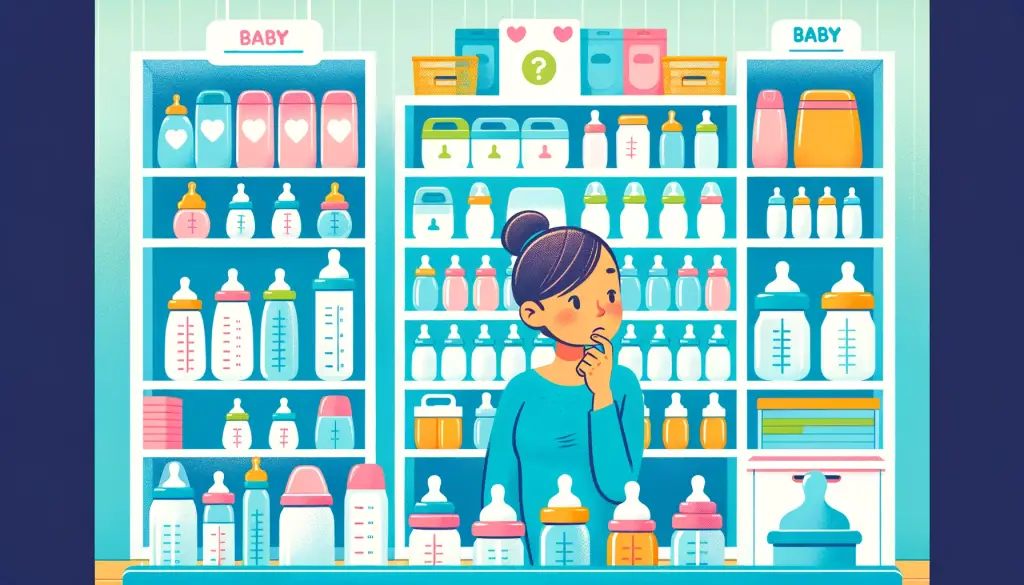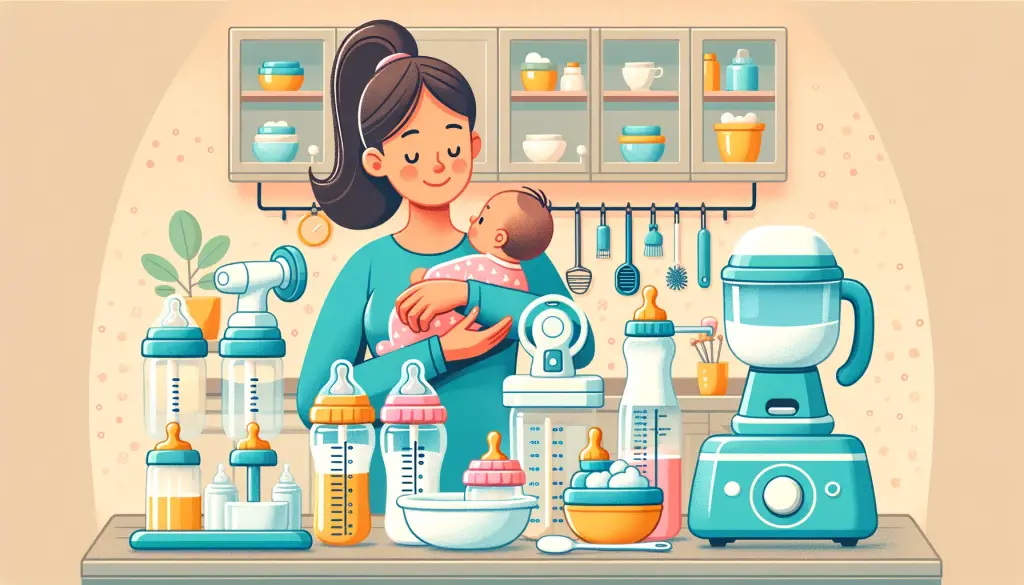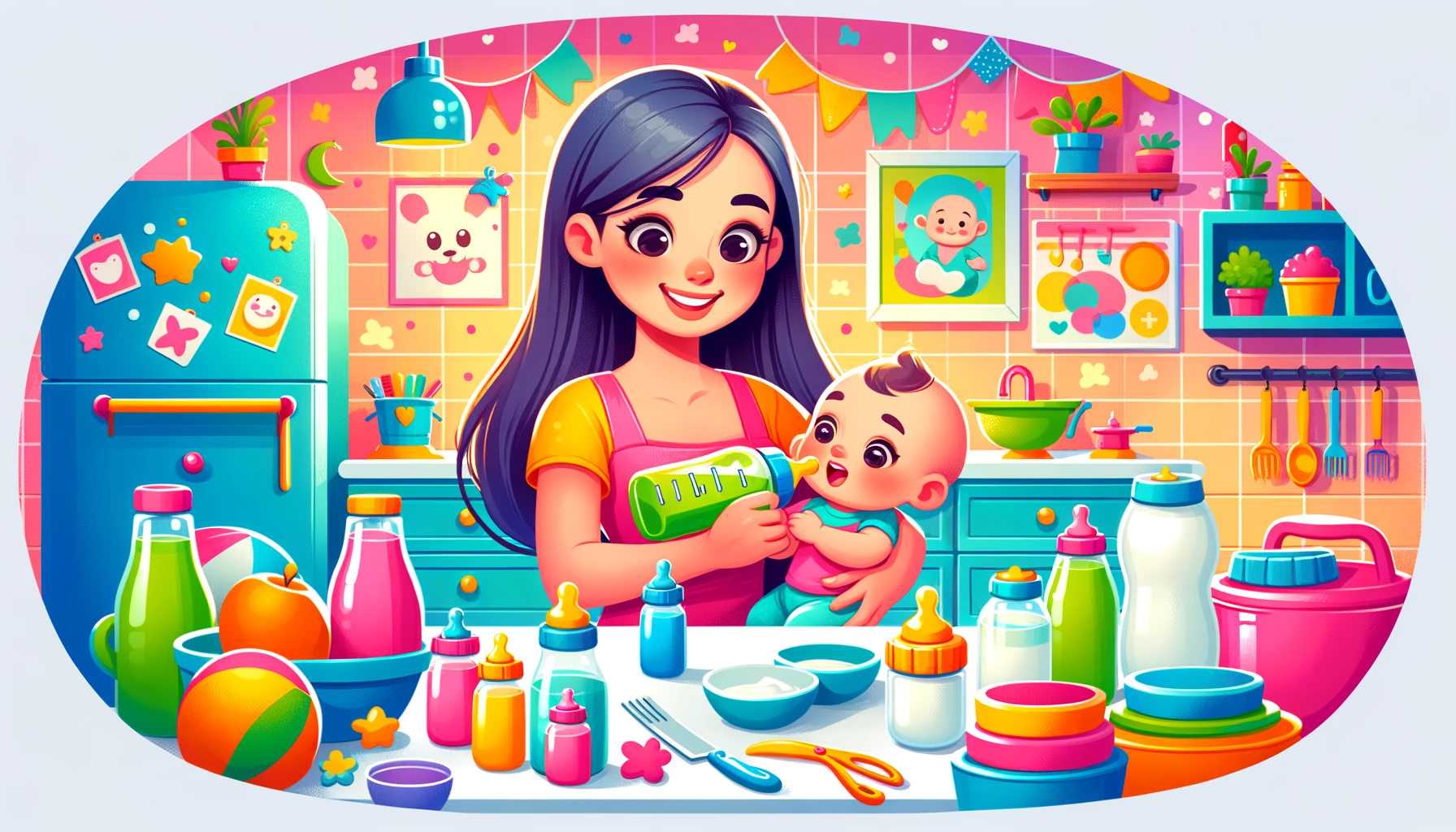
Balancing Breastfeeding and Bottle Feeding: How Many Bottles Do You Need?
So how many bottles do you need while breastfeeding? It’s a good question.
Breastfeeding is an incredible journey, offering numerous benefits for both baby and mother. However, there are times when introducing a bottle becomes essential or practical. Whether it’s due to returning to work, sharing feeding responsibilities with other family members, or addressing specific feeding challenges, bottles can be a helpful addition to your feeding routine.
But, how many bottles do you actually need? This question might seem simple, but the answer varies depending on several factors such as your baby’s age, feeding patterns, and your personal lifestyle. It’s not just about having a number in mind but about ensuring that your baby’s feeding needs are met without disrupting the natural rhythm of breastfeeding.
The Ideal Number of Bottles for Your Baby
Figuring out the right number of baby bottles to have on hand is a common question for new parents, especially those balancing breastfeeding with bottle feeding. The answer varies, depending on several factors including your baby’s age, feeding habits, and your daily routine. Let’s break down these factors to help you arrive at a practical number.
Baby’s Age and Feeding Frequency: Newborn babies typically eat every 2-3 hours, meaning you could be feeding them around 8-12 times a day. For newborns, having 4-6 bottles is a good starting point. This number ensures you have enough bottles to last a day’s worth of feedings, considering some will be in use, while others are being cleaned or sterilized.
As your baby grows and starts feeding less frequently but in larger amounts, you might need fewer bottles. However, having a few extras on hand is always a good idea for convenience and emergencies.
Growth Spurts and Baby’s Appetite: Babies go through several growth spurts in their first year. During these periods, they may feed more often, affecting the number of bottles you’ll need ready. Observing your baby’s hunger cues and appetite can guide you in adjusting the number of feedings and, consequently, the number of bottles you might need.
Insights from Professionals: Lactation consultants and breastfeeding counsellors often provide valuable personalized advice based on your specific situation. They can offer insights into how many bottles would be appropriate, considering your breastfeeding goals and lifestyle. For example, if you’re exclusively breastfeeding and only use bottles occasionally, you might need fewer bottles compared to someone who regularly combines breast and bottle feeding.
In summary, while there’s no one-size-fits-all answer, a general guideline for most parents is to start with 4-6 bottles for a newborn and adjust as needed based on your baby’s growth and feeding patterns. Remember, every baby is unique, and what works best for one may not work for another. Stay flexible and adapt as your baby grows and their feeding habits change.

Mastering the Essentials of Breastfeeding and Bottle Feeding
Navigating the relationship between breastfeeding and bottle feeding is a crucial aspect of early parenthood. Understanding this relationship is key to maintaining a healthy feeding routine for your baby. Breastfeeding is the natural method of feeding infants, providing them with essential nutrients and immune support. However, the addition of bottle feeding to your routine can offer flexibility and convenience, especially for breastfeeding parents.
One of the primary concerns when introducing bottles to a breastfed baby is the potential impact on milk supply. It’s essential to maintain a consistent milk supply to ensure your baby’s nutritional needs are met. The introduction of bottle feeding should be done carefully to complement, not replace, breastfeeding sessions. This balance is important for sustaining an adequate milk supply.
Bottle feeding can be a helpful tool for breastfeeding parents. It allows other family members to participate in feeding, giving the breastfeeding parent a much-needed break and fostering bonding experiences for the baby with other caregivers. For mothers returning to work or needing time away for other reasons, bottle feeding ensures the baby continues to receive breast milk even in their absence.
The key is to find a rhythm that works for both the baby and the breastfeeding parent. This involves understanding your baby’s feeding cues and patterns and responding to them appropriately, whether through breastfeeding or bottle feeding. In the next sections, we will delve into how many bottles you might need and the factors that influence this decision, ensuring your baby’s feeding needs are met while maintaining your milk supply effectively.
Navigating Bottle Feeding for Breastfed Babies: Choices and Challenges
The introduction of bottle feeding in a breastfed baby’s life is a decision many parents face. This choice is influenced by a variety of factors, each unique to the family’s circumstances and the baby’s needs. Understanding why and how to introduce bottles can make this transition smoother for both the baby and the parents.
Parents might choose to introduce bottles to breastfed babies for several reasons. One common reason is the need for flexibility in feeding schedules, especially when a parent returns to work or has other commitments. Bottle feeding allows other caregivers, such as partners or family members, to participate in feeding the baby, which can be both a bonding experience and a relief for the primary breastfeeding parent.
Another factor to consider is the concept of nipple confusion. This term refers to a situation where a breastfed baby might struggle to adjust between breastfeeding and bottle feeding due to differences in the feeding technique required for each. While some babies transition seamlessly between breast and bottle, others might show a preference for one over the other. To mitigate this, choosing the right type of bottle and nipple, and introducing bottles at an appropriate time, are crucial steps.
There are also specific medical scenarios where healthcare professionals might recommend bottle feeding for breastfed babies. For instance, premature babies may not be strong enough to breastfeed initially and might require bottle feeding with expressed breast milk or specialized formula. In such cases, bottle feeding becomes an essential part of the baby’s nutrition and growth plan.
It’s essential for parents to consult with healthcare providers, such as pediatricians or lactation consultants, for personalized advice on introducing bottle feeding. They can offer guidance tailored to the baby’s health and developmental needs, ensuring a smooth transition that supports both the baby’s growth and the breastfeeding relationship.

Selecting the Ideal Bottle for Your Baby: Materials, Flow Rate, and Design
When it comes to bottle feeding, choosing the right bottle is more than just a matter of preference—it’s about finding the best fit for your baby’s needs. The market offers a variety of bottles, each made from different materials like plastic, glass, or stainless steel, and designed with varying flow rates and nipple shapes. Understanding these options can help you make an informed decision that benefits your breastfed baby.
Plastic Bottles: Plastic bottles are lightweight, shatterproof, and widely available, making them a popular choice among new parents. Many are now BPA-free, ensuring safety for your baby. However, they can retain odours and may need to be replaced more frequently than other types.
Glass Bottles: Glass bottles are durable and don’t absorb smells like plastic. They are easy to clean and sterilize, offering a high level of hygiene. However, they are heavier and can break, so it’s important to handle them carefully, especially around older babies who might grab and throw objects.
Stainless Steel Bottles: A less common but highly durable option is stainless steel. These bottles are unbreakable, don’t retain odours, and are generally free from chemicals found in plastics. However, they’re more expensive and you can’t see the milk inside, which might be a drawback for some parents.
Apart from the material, the flow rate and design of the bottle nipple are crucial, especially for breastfed babies. The flow rate needs to be appropriate for your baby’s age and sucking strength. A slow-flow nipple is typically recommended for newborns to mimic the flow of breast milk and ease the transition between breast and bottle. As your baby grows, you might need to adjust the flow rate to meet their developing needs.
The shape of the bottle and nipple can also influence your baby’s feeding experience. Some bottles are designed to reduce the amount of air a baby swallows, which can help decrease gas and colic symptoms. Others are shaped to mimic the breast, which can be helpful for babies who switch between breast and bottle feeding.
When choosing a bottle, consider how different shapes and sizes might cater to your baby as they grow. Newborns generally need smaller bottles, while older babies may require larger ones to accommodate increased milk intake. Remember, every baby is different, and it might take some trial and error to find the perfect bottle that suits your baby’s needs and preferences.
Adapting Bottle Feeding for Special Circumstances: Preemies, Health, and Lifestyle
When it comes to bottle feeding, one size doesn’t fit all, especially in special circumstances like premature birth, specific health issues, and varying family lifestyles. Understanding how these factors influence your bottle-feeding strategy is crucial for ensuring your baby’s well-being and your peace of mind.
Premature Babies and Medical Conditions: For premature babies or those with certain medical conditions, bottle feeding might require more attention and specialized equipment. Preemies often need smaller, more frequent feedings due to their smaller stomach capacity and developmental needs. This might mean having a higher number of smaller bottles ready to accommodate their feeding schedule. Additionally, some health conditions might necessitate the use of specific types of bottles or nipples to aid feeding, as recommended by your pediatrician or neonatologist.
Impact of Family Lifestyle: Your family’s lifestyle is another important factor to consider. If you travel frequently or have a busy work schedule, you might find it practical to have a larger number of bottles to reduce the frequency of washing and sterilizing them throughout the day. On the other hand, if you’re mostly home and have the ability to clean bottles after each use, you might manage with fewer bottles.
Guidance from Experts: The American Academy of Pediatrics and health visitors are invaluable resources for advice tailored to your baby’s needs. They can provide guidelines on the best feeding practices for babies in unique health situations or for families with specific lifestyle considerations. These professionals stay updated on the latest research and recommendations, ensuring the advice they give aligns with the best interests of your baby’s health and development.
In conclusion, while the general rule of thumb might work for many, adapting bottle needs for special considerations is key. Whether it’s for a premature baby, managing health issues, or aligning with your family’s lifestyle, personalizing your approach to bottle feeding can make a significant difference in your baby’s growth and your overall experience as a parent.

From Bottles to Solids: Evolving Your Baby’s Feeding Routine
The journey from exclusively bottle feeding to introducing solid foods is a significant milestone in your baby’s development. As your little one grows, their nutritional needs and feeding methods will evolve, affecting how you use bottles and introduce new feeding equipment like sippy cups.
Changes in Bottle Feeding as Baby Grows: The transition from newborn to older baby brings changes in dietary needs and feeding habits. As solid foods become a part of your baby’s diet, usually around the 6-month mark, the reliance on bottles for nutrition decreases. This shift means you might need fewer bottles, as breast milk or formula becomes a supplement to solids rather than the main source of nutrition. The type and size of bottles may also change, with older babies potentially requiring bottles with a faster flow rate to satisfy their growing appetites.
Introducing Sippy Cups and Feeding Cups: Around the age of 6 to 12 months, many parents begin to introduce sippy cups as a transition from bottles to regular cups. Sippy cups help develop your baby’s drinking skills and independence. They come in various designs – some with handles, others with different types of spouts – to suit different stages of your baby’s development. Just like with bottles, it may take some trial and error to find the type your baby prefers and adapts to easily.
Maintaining Cleanliness and Safety: Regardless of the type of feeding equipment you use, cleanliness and safety are paramount. Regularly sterilize bottles, nipples, and sippy cups, especially for younger babies whose immune systems are still developing. As babies grow older and their immune systems strengthen, thorough washing with hot soapy water can be sufficient. Always check bottles and nipples for signs of wear and tear, like cracks or discolouration, and replace them when needed to ensure your baby’s safety.
As your baby transitions from a newborn to a more solid-based diet, their bottle needs will change. This period is about adapting to your baby’s evolving needs and introducing new feeding methods that support their development. By staying informed and responsive to these changes, you can ensure a smooth and healthy feeding journey for your little one.
Answering Your Top Questions: Bottle Feeding and Breastfeeding Insights
Navigating the early stages of parenthood comes with a myriad of questions, especially regarding bottle feeding and breastfeeding. In this section, we address some of the most common concerns new parents have, providing clear, informative answers to help ease your journey.
1. How often should I sterilize baby bottles?
Sterilizing baby bottles is crucial to protect your baby from bacteria and infections, especially in the first few months. It’s recommended to sterilize bottles before the first use and then regularly thereafter. For newborns, sterilize bottles after each use. As your baby gets older and their immune system strengthens, thorough washing with hot soapy water becomes sufficient.
2. How do I choose the right nipple flow for my baby?
Selecting the right nipple flow depends on your baby’s age and feeding ability. Start with a slow-flow nipple for newborns, as it mimics the natural flow of breastfeeding. As your baby grows, you may need to switch to a medium or fast flow nipple. Watch for signs that your baby is ready for a faster flow, like frustration during feeding or taking longer than usual to finish a bottle.
3. What are feeding cues I should look out for?
Feeding cues include behaviours like sucking on hands or fingers, smacking lips, and turning the head towards the breast or bottle. Crying is a late sign of hunger. By responding to these early cues, you can feed your baby before they become too hungry and agitated, making feeding sessions more relaxed and effective.
4. How can I maintain a good milk supply when bottle feeding?
To maintain a healthy milk supply while bottle feeding, it’s important to pump milk regularly, especially during times when you would normally breastfeed. This helps signal your body to continue producing milk. Staying hydrated, well-nourished, and getting enough rest also plays a crucial role in maintaining your milk supply.
By addressing these frequently asked questions, we hope to provide clarity and confidence to new parents navigating the complexities of feeding their babies. Remember, each baby is unique, and what works for one may not work for another. Trust your instincts, and don’t hesitate to seek advice from healthcare professionals when needed.

Essential Tips and Considerations for Bottle Feeding Your Baby
Navigating the world of bottle feeding can be a daunting task for new parents. From selecting the right equipment to understanding the nuances of feeding techniques, there’s a lot to consider. This section offers practical advice and key considerations to help you confidently feed your baby, whether with breast milk or infant formula.
Overview of Bottle Feeding: Types and Techniques
Choosing the right bottle is crucial for your baby’s comfort and health. Plastic baby bottles are lightweight and shatterproof, making them a popular choice. Silicone bottles, on the other hand, are soft and more breast-like, which can be helpful for babies transitioning from breast to bottle. It’s important to select a bottle that reduces air intake to prevent colic and minimize the risk of ear infections.
Breast Milk and Infant Formula: Making the Right Choice
Whether to feed your baby breast milk or infant formula is a significant decision. Breast milk offers optimal nutrition tailored to your baby’s needs, but infant formula is a viable alternative when breastfeeding isn’t possible. Consultation with a lactation consultant or health visitor can provide personalized advice, ensuring you make the best choice for your baby’s nutritional needs.
Preparing and Storing Milk: Best Practices
How much milk your baby needs will change over time, especially during the first few months. In the first week and month, babies usually consume small amounts of milk frequently. Proper storage is key — breast milk can be stored at room temperature for a short period, while formula should be used promptly or refrigerated. Always follow guidelines to ensure milk is safe and nutritious for your baby.
Feeding Techniques for Baby’s Comfort and Health
The right feeding technique can make a big difference in your baby’s comfort and health. Hold your baby in a semi-upright position and tilt the bottle to ensure a steady flow of milk. This can prevent issues like tooth decay and ensure your baby gets enough milk. Also, be mindful of the temperature of the milk; it should be warm, not hot, to avoid scalding the baby’s mouth.
Cleaning and Sterilization: Keeping Baby Safe
Keeping your baby’s bottles clean and sterilized is paramount. Use a bottle brush for thorough cleaning and consider a steam sterilizer for effective sterilization. Pay special attention to areas like the neck of the bottle and the nipples where milk residue can accumulate.
Navigating Growth Spurts and Feeding Challenges
Babies often experience growth spurts, during which their feeding patterns may change, requiring more milk or more frequent feedings. Recognize the signs of a growth spurt and adjust accordingly. If you encounter feeding challenges, don’t hesitate to seek medical advice or consult a breastfeeding counsellor.
Innovations and Alternatives in Bottle Feeding
The bottle-feeding market is constantly evolving, with innovations like anti-colic bottles and slow-flow nipples designed to mimic the natural feeding rhythm. These can be especially helpful for babies who struggle with gas or colic. As your baby grows, you may also explore different teats and bottles to suit their developing needs.
In conclusion, while bottle feeding may seem overwhelming at first, understanding these key aspects can make it a more manageable and enjoyable experience. Remember, every baby is unique, and what works for one may not work for another. Stay flexible, observe your baby’s cues, and adjust your approach as needed to ensure a happy and healthy feeding journey.
Wrapping Up: Your Guide to Bottle Feeding While Breastfeeding
As we conclude this comprehensive guide on balancing breastfeeding with bottle feeding, let’s revisit the key takeaways to help you make informed decisions for your baby’s feeding journey. The number of bottles you need varies based on several factors, including your baby’s age, feeding frequency, growth patterns, and your family’s lifestyle.
Remember, newborns may require more frequent feedings with smaller bottles, whereas older babies might feed less often but with larger quantities. The introduction of solid foods will gradually reduce the reliance on bottles. Special considerations, like premature birth or specific health conditions, may also affect your bottle-feeding approach.
Above all, trust your instincts as a parent. You know your baby better than anyone else. While guidance and general rules can be helpful, they are not one-size-fits-all solutions. Don’t hesitate to consult with healthcare professionals, such as lactation consultants or pediatricians, for personalized advice that caters to your baby’s unique needs.
Your journey through parenting, particularly in these early stages, is unique and personal. By staying informed, adaptable, and attentive to your baby’s cues, you’ll navigate the world of breastfeeding and bottle feeding with greater confidence and ease.

